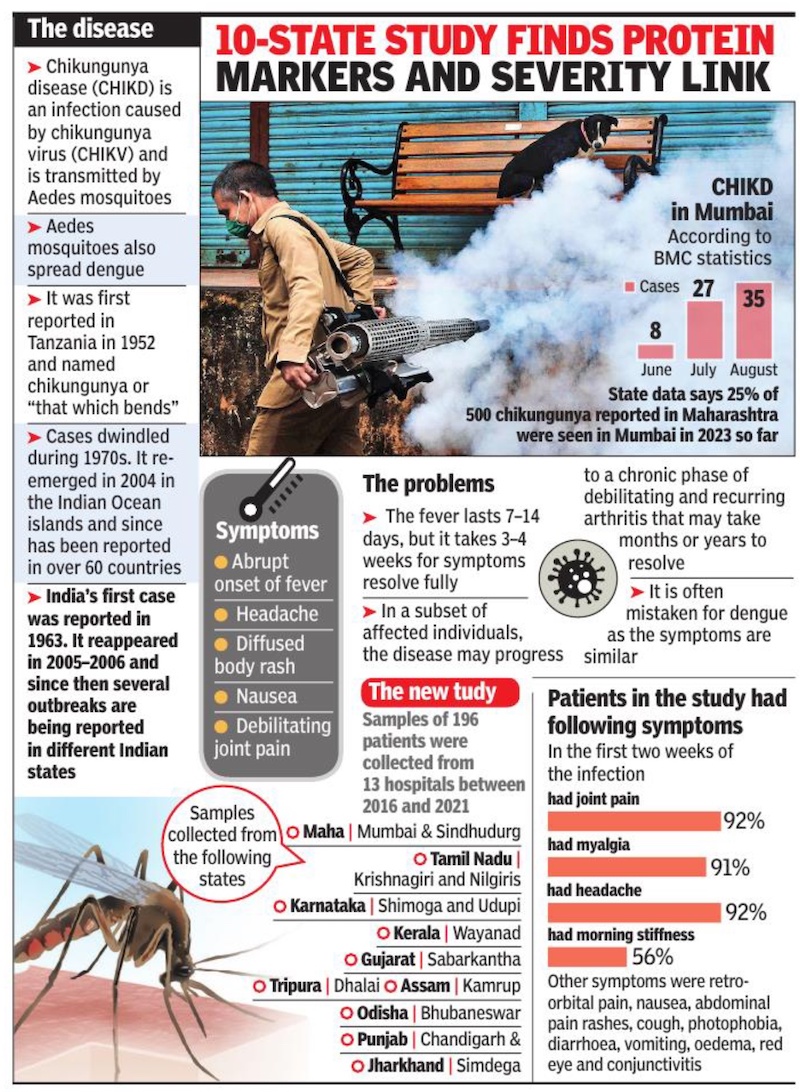Chikungunya and India
This is a collection of articles archived for the excellence of their content. |
How Chikungunya affects Indians
A 2023 study
Malathy Iyer, Sep 11, 2023: The Times of India

From: Malathy Iyer, Sep 11, 2023: The Times of India
Mumbai : For the first time, local scientists have mapped out how chikungunya — a “backbreaking” viral fever caused by the same mosquitoes that spread the deadly dengue virus —affects Indians across variousstates. One of the findings is that rashes, globally considered a common symptom of chikungunya, made an appearance in India recently. And, the chikungunya virus (CHIKV) rashes are more likely in patients in Chandigarh than, say, in Maharashtra orKarnataka.
Doctors from 13 hospitals across 10 states, including Maharashtra, collected samples from 196 patients and “grew” CHIKV in laboratory to find, among other details, certain proteins associated with fast growing viralloads. The study, published in the latest edition of ‘The Lancet Regional Health — Southeast Asia’, is a “significant step to understand CHIKV”, said one of the main authors Sujatha Sunil from the Delhi-based International Centre for Genetic Engineering and Biotechnology. “It highlights the role of specific molecules in disease severity and offers a glimpse into how the virus replicates,” she said. Co-author Jayanthi Shastri, former head of microbiology at Nair Hospital, said chikungunya’s complexities are crucial for effective prevention and treatment. “Most of chikungunya’s symptoms mimic or overlap with dengue, except for the joint pain that could linger in some for months or even years,” shesaid.
Experts believe chikungunya is severely underdiagnosed in India. For instance, statistics from Maharashtra public health department say roughly 500 cases have been detected in the state this year; about 25% are fromMumbai. The study used samples of patients treated at BMC-run Nair Hospital, Mumbai Central, and found chikungunya in Mumbai is mainly a post-monsoon occurrence. “Our study found that at least half of the patients with chikungunya disease suffered from joint pain in the initial days, but the period could stretch to months or years for 75% of those with pain,’’ saidShastri.
Of the 196 patients whose samples were collected between 2016 and 2021, 51 patients shared their samples a second time — a month after symptoms began — so scientists could study the effect of thevirus. “During recovery, the body seemed to overreact, and we recorded elevated levels of proinflammatory markers such as IL-6, IL-1, IL-9 and IP-10. At the same time, anti-inflammatory cytokines like IL-4 and IL-10 decreased, linked to lingering joint pain,’’ said Anitha Jagadesh from the Manipal Institute of Virology,Udipi.
Apart from classical CHIKV symptoms (fever, joint pain and morning stiffness), researchers identified uncommon symptoms such as retro orbital (eye) pain, nausea, abdominal pain, rashes, photophobia and conjunctivitis. Sunil said a crucial point of the study was how different the virus isolated from patients behaved in cell culture. “This provides an idea of how virulent these viruses may be and how different they are in comparison with one another in terms of infectivity,” she said. Doctors said unavailability of rapid diagnostic tests is one reason for low detection rate.